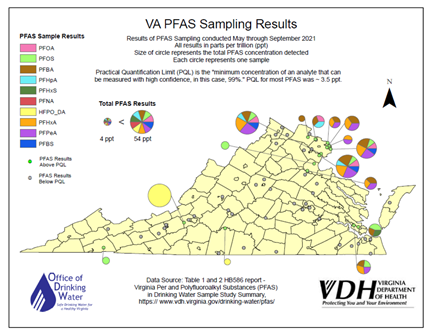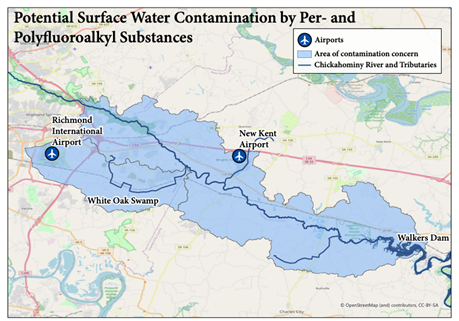PFAS is an acronym for a group of chemicals that share a similar structure that makes them extremely stable. This structure allows these chemicals to be oil and water resistant and long lived; traits that are good if you want to use them to create non-stick pans, waterproof clothing and rugs, food packaging, and firefighting foam. As a consequence, thousands of PFAS chemicals have been manufactured by the chemical industry since the 1940s, some with names you’ll recognize, like Teflon, Scotchguard, and Gen-X. You can be exposed to PFAS by drinking contaminated water, eating fish from contaminated water, exposure to contaminated soil or dust, eating some foods that have been packaged in materials containing PFAS, or using some products like stain-resistant carpet or water repellant clothing that contains PFAS.
The persistent nature of PFAS also gives them a much darker side. These chemicals hang around the environment for a long time before being broken down, earning them the nickname “forever chemicals”. PFAS chemicals have gotten much more attention recently after awareness of the negative health effects has become more widespread because of recent news stories, movies like Dark Waters or a recent episode of Last week tonight with John Oliver. Health effects can include cancer, preeclampsia, increased cholesterol, decreased vaccine response, and liver issues. Despite these concerns, there are currently no federal or Virginia regulations that set a limit on the amount of PFAS allowed in our drinking water.
In 2020, JRA started a campaign to protect Virginians and our waterways from PFAS contamination, troubled by the lack of urgency at our state environmental and public health agencies. We helped pass legislation that year directing the Virginia’s Department of Health (VDH) to begin testing public drinking water sources for contamination and to set drinking water standards for at least two types of PFAS as well as two other chemical contaminants of concern.
Over the course of 2021, JRA participated in the workgroup convened by VDH to conduct the drinking water study. Prior to the workgroup convening, there were several known contaminated sites including the DuPont Spruance Plant outside of Richmond and several military and government installations including NASA’s Wallops Island facility, Norfolk Naval Station, Oceana Naval Station, Joint Base Langley-Eustis, and Fentress Auxiliary Landing Field.
The workgroup study was limited in scope, as it only tested samples from 45 waterworks for 25 different types of PFAS. Of the 63 samples collected, PFAS were found in 15, or roughly 24%. These positive tests were generally located in Northern Virginia, Hampton Roads and Roanoke. While none of the positive samples exceeded the EPA’s current health advisory limit for two types of PFAS, they do show that PFAS contamination is present in Virginia’s drinking water and warrants further investigation. There are more than 2,800 waterworks across the Commonwealth and more information is needed about where the contamination may be coming from. Recent news from EPA also suggests that the current health advisory may be much too high to adequately protect human health, and lower, more protective limits may be forthcoming.
Recent findings within the Chickahominy watershed offer a model for how drinking water safety standards, and the more regular testing that come with them, can protect public health by identifying problems and spurring further investigation. Source-water protection sampling done by Newport News Waterworks found elevated levels of PFAS in water they were drawing from the Chickahominy River near Walker’s Dam. Subsequent testing further upstream found high levels of PFAS in White Oak Swamp, downstream of Richmond International Airport, which is collocated with the Army and Air National Guard and the Richmond Fire Academy, all potential users of firefighting foams. This is the first documented finding of surface water contamination to this degree in the Commonwealth, 30-40 times higher than the EPA’s current non binding health advisory level.
The Department of Environmental Quality (DEQ), VDH, and Henrico County are working together as part of a multi-agency taskforce to conduct an l investigation of the PFAS contamination within the Chickahominy watershed, including ambient water testing, soil testing, fish tissue sampling, and public and private well testing in the area. Despite finding funding to support this monitoring, DEQ has limited funding for additional ambient surveillance at approximately 30 other locations of concern, including areas identified with positive test results in VDH’s Phase I drinking water study. Current funding will only be available through June of 2022, despite the need for continued and consistent work by our state agencies to better understand the risks posed by PFAS.
- Support HB1011, legislation from Delegate Guzman that will reconvene a stakeholder workgroup to oversee additional drinking water testing based on the findings and recommendations of the first workgroup.
- Provide funding for state agencies to continue testing for PFAS in our drinking water and our waterways by supporting these budget amendments:
- Item 378 #12h and #1s – $320,000 in FY2023 for surface and ground water PFAS surveillance;
- Item 378 #4h – $300,000 per year for PFAS fish tissue sampling; and
- Item 296 #2h – $600,000 in FY2023 for the continued study of PFAS contamination in drinking water
To learn more about the findings and recommendations of the VDH PFAS workgroup, see this report.



